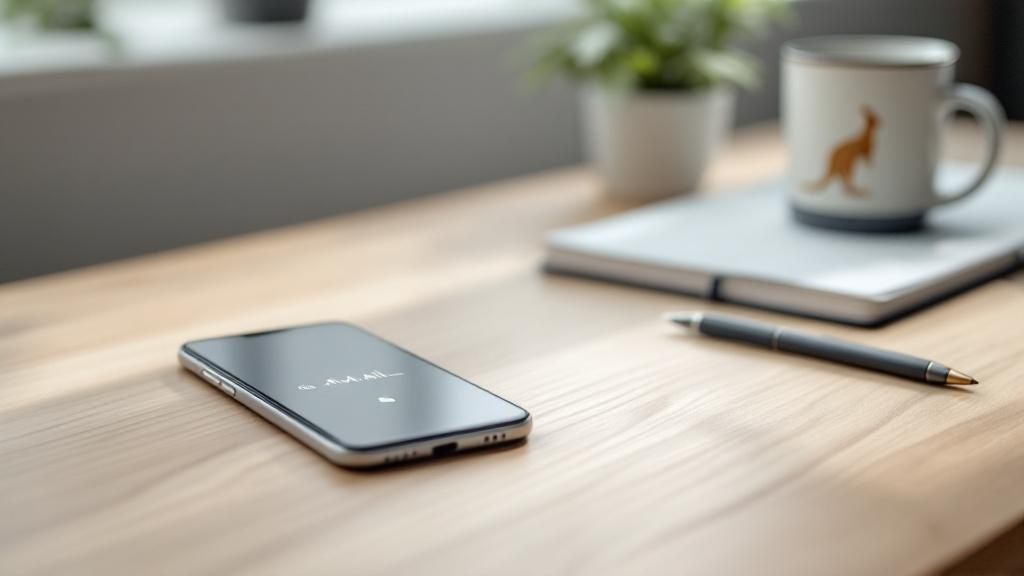A well-crafted voicemail greeting isn't just a placeholder message. It’s a short, sharp, professional heads-up that tells callers why you can't pick up and exactly when you'll get back to them. Think of it as the digital front door for your business—it’s often the first impression you make, and it sets the tone for everything that follows.
Why Your Voicemail Still Shapes Client Perception
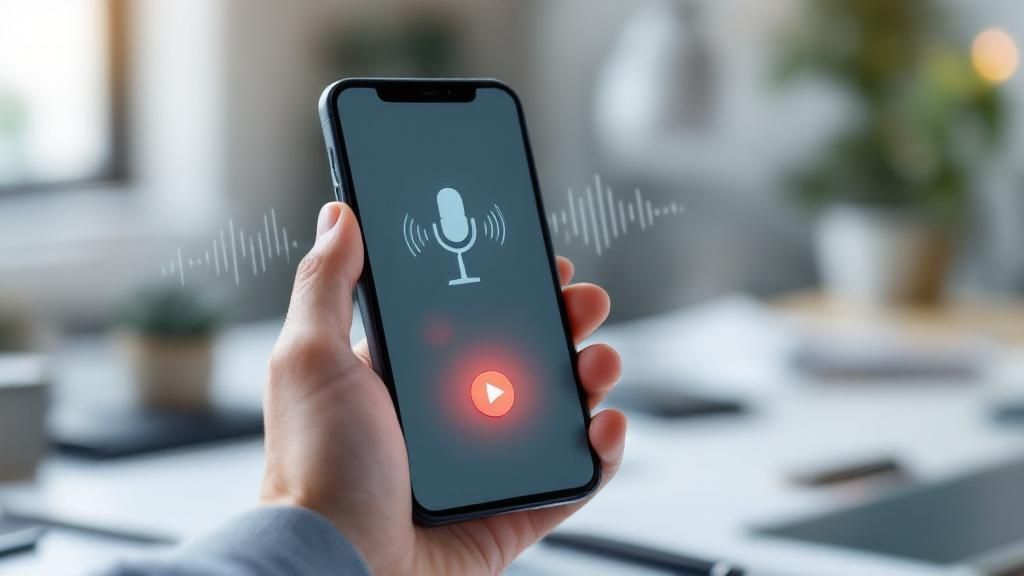
In a world of instant messaging and DMs, it’s easy to think of voicemail as a bit of a dinosaur. But for Australian businesses, a professional voicemail greeting is way more than just a missed call alert. It's a critical moment that can make or break a client's perception of your brand.
Put yourself in their shoes for a second. They’ve taken the time to actually call you, looking for a real, human connection. What happens when they hit a generic, robotic, or—even worse—an ancient, out-of-date message? It’s frustrating. It quietly signals that their call isn't a top priority and that maybe your business isn't quite on the ball.
Building Trust, One Greeting at a Time
A polished, thoughtful voicemail script works wonders for building trust right off the bat. It confirms to the caller they've dialled the right number and reassures them their query will be handled properly. It’s a small detail, but it projects an image of an organised, customer-first operation.
A clear, confident message ticks a few important boxes:
- Manages Expectations: It tells them when to expect a call back, which immediately cuts down on any uncertainty or annoyance.
- Provides Alternatives: Offering another way to get in touch, like an email address or a colleague’s number for urgent stuff, shows you’re proactive and genuinely trying to help.
- Reinforces Professionalism: The tone, clarity, and words you use all reflect the standard you set for your business communication.
On the flip side, nothing screams unprofessional like the default network greeting ("You have reached 04…"). It creates an instant moment of doubt for the caller. Did they get the number wrong? Is this business even still operating? This is especially damaging for tradies, real estate agents, or consultants where trust is the name of the game.
"Your voicemail isn't just a placeholder; it's a strategic communication tool. Every missed call is an opportunity to reinforce your brand's reliability and professionalism, turning a moment of unavailability into a positive touchpoint."
The Strategic Value of a Good Script
At the end of the day, creating a solid voicemail greeting isn't just another box to tick on your admin list—it’s a smart branding move. In industries where personal relationships are everything, this touch of personalisation sets a high standard. It tells clients you value their time and are serious about clear, reliable communication.
By spending just a few minutes recording a professional greeting, you turn a passive system into an active asset. It becomes a tool that doesn't just take messages, but actually boosts your reputation, builds client confidence, and makes sure no opportunity slips through the cracks, even when you can't get to the phone.
Anatomy of an Effective Voicemail Greeting Script
Crafting a solid voicemail greeting is a bit like building a bridge. Every piece has to be in the right place to get your caller from "I have a question" to "I know what to expect next". It's not just about stringing together random bits of information; there's a simple, logical flow to it that respects the caller's time and gives them everything they need in one hit.
Think of it as a four-part formula for clarity and professionalism. You're essentially guiding their next action, making it dead simple for them to leave a useful message or find another way to get what they need.
Let's break down exactly what makes a voicemail greeting work, piece by piece. Below is a quick table outlining the core components.
Anatomy of an Effective Voicemail Greeting
| Component | Purpose | Example Phrase |
|---|---|---|
| Identification | Immediately confirms they've reached the right person or business. | "Hi, you’ve reached Chloe Bennett at Apex Mortgages…" |
| Reason for Missing Call | Briefly explains why you can't answer, managing their expectations. | "…I'm either on another call or away from my desk right now…" |
| Set Callback Expectations | Tells them when they can expect to hear back from you. | "…I check my messages at 11 am and 4 pm daily…" |
| Call to Action | Clearly instructs the caller on what to do next. | "…so please leave your name, number, and a brief message." |
By including each of these elements, you create a greeting that's professional, helpful, and efficient for everyone involved.
Start With Clear Identification
First things first, let them know they've dialled the right number. State your name and your business name clearly right at the start. This simple step gets rid of any confusion and sets a professional tone from the get-go.
A straightforward opener like, "Hi, you’ve reached Chloe Bennett at Apex Mortgages," is perfect. It’s direct, professional, and instantly tells the caller they're in the right place, building credibility straight away.
Explain Your Unavailability Briefly
Next up, tell them why you missed their call. You don't need to write a novel here; a short, clear statement works best. Something as simple as, "I'm either on another call or away from my desk right now," is polite and does the job.
This little bit of info manages their immediate expectations. The caller knows you're not just ignoring them, you're just tied up. Keeping it brief is key – people have short attention spans. In Australia, we’re all drowning in mobile notifications. With nearly 34.4 million mobile connections for a population of about 26 million, people are constantly juggling calls and messages, so being concise is a sign of respect.
Set Expectations for a Return Call
This is where a lot of greetings fall flat. Don't just ask them to leave a message and hope for the best. Give your caller a specific timeframe for when you'll get back to them. This one detail is crucial for managing expectations and cuts down on those annoying follow-up calls.
Instead of a vague "I'll call you back soon," be specific:
- "I'll return your call within four business hours."
- "I check my messages at 11 am and 4 pm daily and will get back to you then."
- "I'll respond to all messages by the end of the business day."
This small detail reassures the caller and shows you've got a system in place. If you're looking to make this process even smoother, a professional voicemail to text service can transcribe messages for you, making it much quicker to review and respond.
A professional voicemail greeting should be kept between 20 and 30 seconds. Any longer, and you risk the caller hanging up before they even hear your instructions.
This isn't just a guess; caller drop-off rates shoot up when a message drags on.
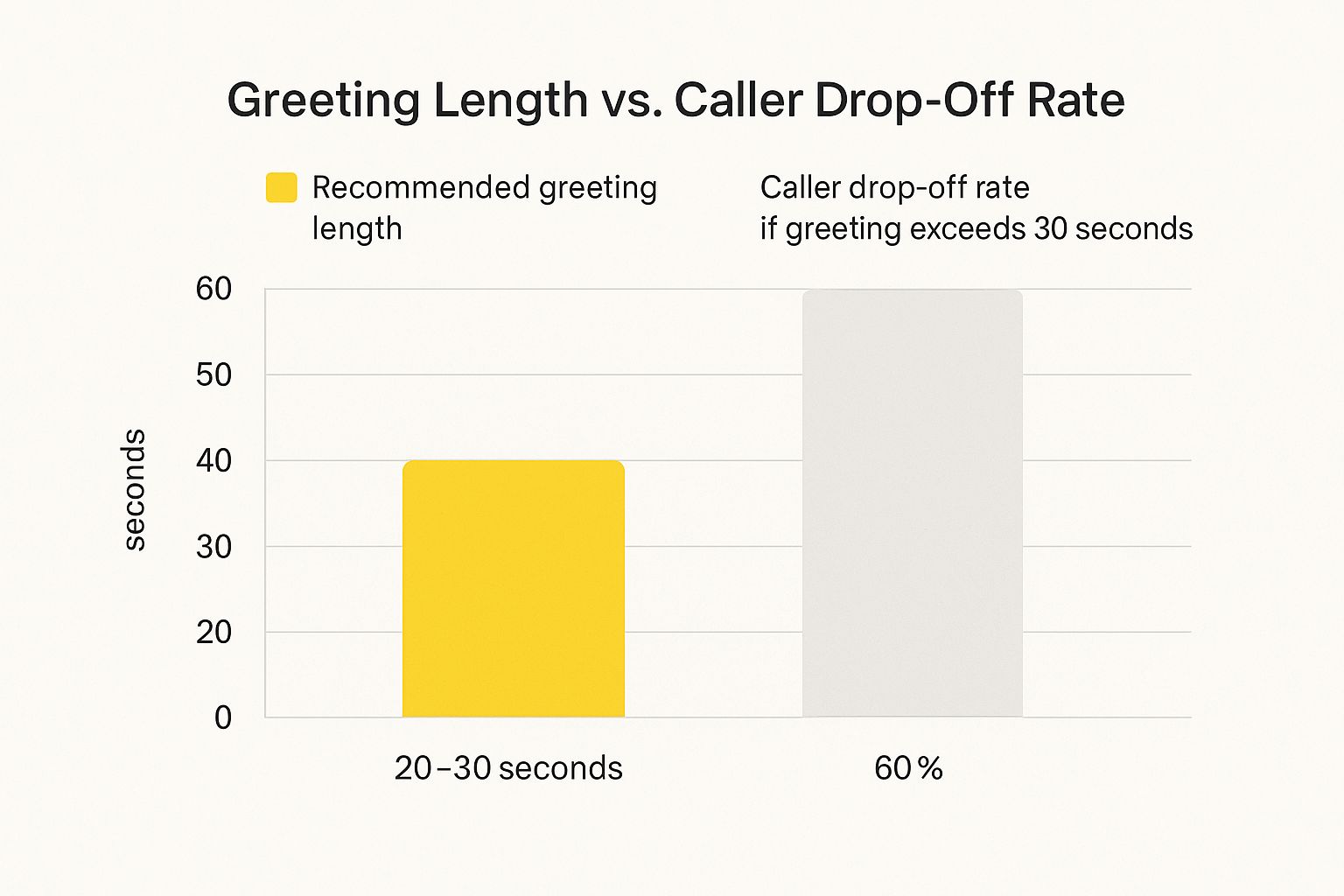
The data doesn't lie. Once you push past that 30-second mark, you’re losing callers. That means your all-important call-to-action might never even be heard.
Voicemail Scripts for Real Business Scenarios
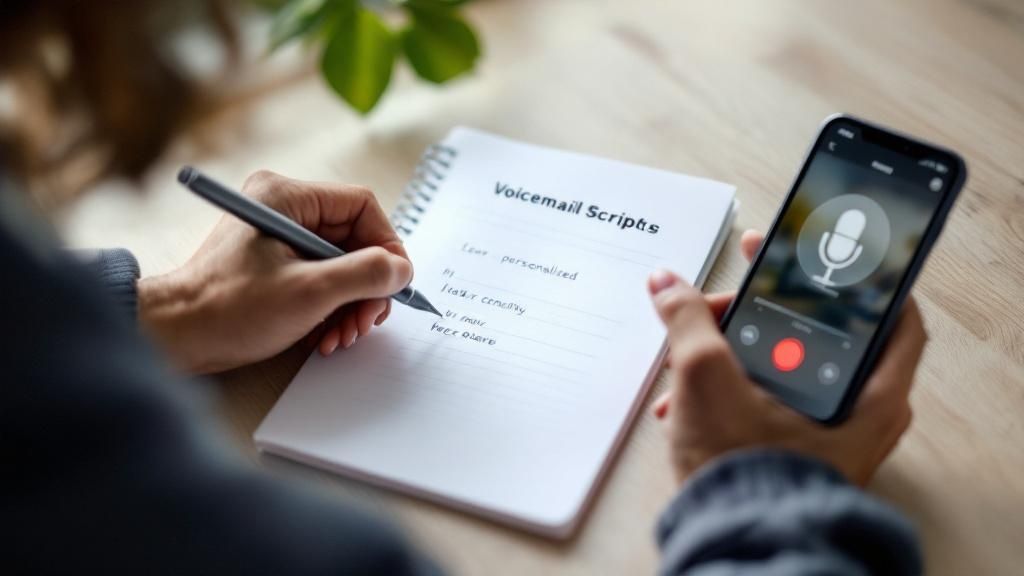
Let's be honest, a generic, one-size-fits-all script just doesn't cut it in the real world. The message a caller hears should make sense for why they're calling. A potential new client reaching out to your sales line needs a completely different experience than an existing customer trying to get through to support.
Getting your voicemail scripts right for different situations shows you’re organised and professional. It's about much more than just taking a message; you're managing their experience and letting them know their call is important, even when you can't pick up straight away.
For Individual Professionals
If you're a mortgage broker, a consultant, or a tradie, your personal brand is everything. Your voicemail is often the first impression you make, and it’s a direct reflection of your professionalism. You want to sound approachable but reliable, making it clear they've got the right person and you'll get back to them promptly.
Here’s a solid example:
"Hi, you've reached Ben Carter. I'm currently with a client or on-site, but I'm committed to returning your call. Please leave your name, number, and a brief message, and I'll get back to you within four business hours. Thanks for calling."
This script works because it's direct and sets a crystal-clear expectation. Promising a callback within "four business hours" is so much more reassuring than a vague "as soon as possible."
For Team Departments
When someone calls a general line for sales or support, they need to know two things: they're in the right place, and what to do next. This is your chance to direct traffic efficiently and even offer other ways to get help. It can seriously cut down on caller frustration and lighten the team's workload.
For a Sales Department:
"Thanks for calling the Sales team at Apex Solutions. All our account managers are currently assisting other clients. Please leave your details, and the next available team member will return your call. For pricing and product info, you can also visit our website at ApexSolutions.com.au."
For Customer Support:
"You've reached Customer Support. We are currently experiencing high call volumes. For the quickest resolution, please visit our online Help Centre or email us at support@company.com.au. Otherwise, leave a message with your account number, and we'll call you back in the order your message was received."
These scripts immediately offer value by pointing callers to other resources. It empowers them and shows you're committed to helping them efficiently. If you need a few more ideas, our complete guide has plenty more voicemail greetings for business to check out.
For After Hours and Holiday Closures
Nothing screams "we're not organised" like an outdated voicemail greeting. Always switch to a temporary script for planned closures to keep people in the loop. It’s a small thing, but it prevents a lot of confusion and shows your business is on top of things.
A Simple Holiday Script:
"Thank you for calling [Company Name]. Our office is currently closed for the public holiday and will reopen at 9 am on [Date]. Please leave a message, and we will respond upon our return. We hope you have a safe and enjoyable holiday."
Why does this work so well?
- It’s specific: It gives the exact reopening date.
- It’s professional: It keeps your brand image sharp, even when you're closed.
- It manages expectations: Callers know not to sit by the phone waiting for a reply.
For Special Promotions or Announcements
Did you know your voicemail can be a low-key marketing tool? If you've got a big sale on or some important company news, mentioning it in your greeting can grab the attention of someone who's already trying to connect with you.
Give this a try:
"Hi, you've reached [Your Name] at [Company Name]. Thanks for your interest in our End of Financial Year sale! I'm currently busy helping other customers, but please leave your details, and I'll call you back to discuss our special offers. Talk soon!"
This approach flips a missed call into an opportunity. It confirms the caller's interest and builds a little anticipation for your callback, making your follow-up even more effective.
Take Your Voicemail From Good to Great
A basic voicemail script gets the job done, sure. But why stop there? With a few smart moves, you can turn your voicemail from a passive message-taker into a powerful tool that actively works for your business.
These strategies go beyond just the standard "leave a message" script. They’re about creating a more seamless, professional, and genuinely helpful experience for anyone who calls you.
One of the biggest game-changers is making your voicemail work for you even when you're not listening to it. Think about integrating it into your daily workflow. Services that convert your voicemails to email or text are brilliant for this. You can scan messages at a glance, figure out what's urgent, and keep a record of everything without ever having to dial in. This simple change can slash your response times.
Make Sure You’re Understood by Everyone (and Everything)
The way people use their phones has completely changed. Voice assistants aren't a gimmick anymore; they're part of daily life for a lot of Aussies.
That's why you need to make sure your greeting is crystal clear for assistants like Siri or Google Assistant. Speak clearly, don't mumble, and steer clear of industry jargon that a voice-to-text program could easily mess up.
With so many people using voice search and making hands-free calls in the car, your greeting has to be perfectly easy to understand, even when played through a tinny speaker.
Keep Your Greeting Fresh with Real-Time Updates
A static, set-and-forget greeting can feel impersonal and quickly become out of date. The real pro move? Updating your message to reflect what you're actually doing. Stuck in meetings all morning? Record a quick greeting that tells people exactly that.
"Hi, you've reached Ben Carter. I'm in client meetings until 1 pm today, but I'll be checking messages between sessions. Please leave your details, and I'll get back to you this afternoon. For anything urgent, please send a text."
This kind of detail is a masterclass in managing client expectations. It gives callers a precise, up-to-the-minute status update and shows them you're organised and respect their time.
Use Tech to Build a Smarter System
If you're serious about taking your voicemail to the next level, it might be time to look at modern VoIP Solutions. These phone systems often come packed with features that can seriously elevate your customer experience.
Here’s a taste of what they can do:
- Automated Call Routing: You can set up rules to automatically forward calls to another team member if you don't return a message within a set time. No more leads falling through the cracks.
- Voicemail-to-Text Transcription: Get your messages as text. This makes them searchable and way easier to action quickly.
- Custom Greetings for Different Callers: Imagine having one message for new clients and a different, more familiar one for existing customers. It’s a small touch that personalises the whole interaction from the get-go.
Common Voicemail Mistakes and How to Fix Them
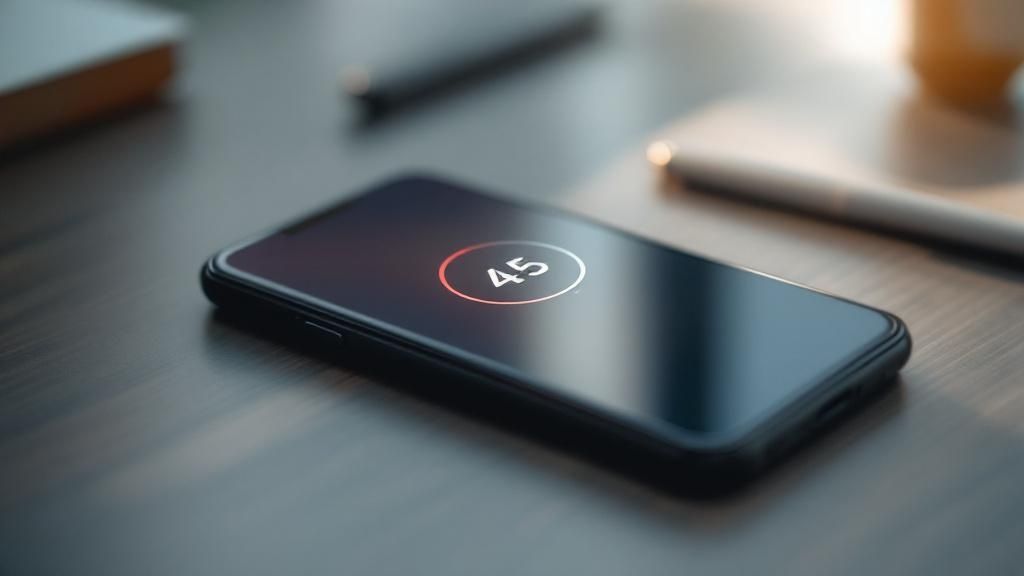
Even with the best of intentions, it’s surprisingly easy to get a voicemail greeting wrong. A small slip-up can make your business sound unprofessional, disorganised, or just plain unhelpful. That can be enough to cost you a valuable lead or leave a current client feeling frustrated.
The good news is that recognising these common traps is the first step to fixing them. From dodgy audio quality to outdated info, these mistakes are everywhere—but they’re also incredibly simple to correct once you know what you’re looking for.
Forgetting to Update Your Message
This one is a classic. We’ve all been there: calling a business in February only to hear a cheerful message about their Christmas closure. It immediately signals that nobody’s paying attention to the details.
- The Culprit: "Thanks for calling, our office is closed for the Christmas break and will reopen on January 2nd." (Heard in March)
- The Fix: This is an easy one. Whenever you set a temporary greeting for a holiday or event, pop a reminder in your calendar to switch it back the day you return. It’s a simple habit that keeps you looking professional all year round.
Sounding Unenthusiastic or Rushed
Your tone of voice speaks volumes. If you sound bored, monotone, or like you’re just trying to get the recording over with, callers will pick up on that vibe instantly. A rushed message isn't just off-putting; it can also be hard to understand.
Your voicemail greeting is a direct reflection of your customer service. A warm, clear, and confident tone reassures callers that you value their time, even when you can't pick up the phone.
So, slow down. Smile when you speak (seriously, it makes a huge difference to your tone), and read your script with some friendly, professional energy. A little enthusiasm goes a long, long way.
Providing Vague or Useless Information
Another common pitfall is leaving callers hanging with vague instructions. Phrases like, "I'll call you back as soon as I can," are pretty much useless. Does that mean in an hour, tomorrow, or next week? This kind of uncertainty is frustrating and often leads to them calling you again.
- Before: "You've reached Alex. Leave a message and I'll get back to you when I'm free."
- After: "You've reached Alex. Please leave your name and number, and I'll return your call within three business hours."
Being specific is everything. It sets expectations and shows respect for the caller's time. This is a big reason why many Australian businesses are now using voicemail-to-email solutions; they need greetings that prompt clear, actionable messages that can be dealt with quickly. In fact, businesses using this tech can get to their messages up to 74% faster than those sticking with old-school systems. You can check out more on how Australian businesses are boosting their voicemail game over at callin.io.
Got Questions About Your Voicemail Greeting? We’ve Got Answers.
Even with the best templates in hand, you might still have a few questions floating around about getting your voicemail greeting script just right. It’s completely normal.
So, let's tackle some of the most common queries we hear from Aussie business owners. We'll clear things up with practical, real-world advice.
How Often Should I Update My Voicemail Greeting?
The golden rule is simple: update your greeting whenever your availability changes in a big way. For your standard, day-to-day message, giving it a quick once-over every three months is a solid habit. It keeps things fresh and accurate.
But, you absolutely need to record a temporary greeting for specific situations. Think of it as a professional courtesy. This includes:
- Public Holidays: Don't just say you're closed. Tell callers the exact date you'll be back in action.
- Extended Leave: If you're taking a well-deserved break, let people know you're away and give them an alternative contact. It manages expectations beautifully.
- Team Offsites: Is the whole crew out for the day? A quick message explaining this prevents callers from feeling ignored.
A common slip-up is forgetting to switch back to your regular message. Trust me, it happens. A quick calendar reminder for your return date is all it takes to stay on top of it.
What's the Ideal Length for a Professional Voicemail Greeting?
You want to aim for the sweet spot, which is right between 20 and 30 seconds.
That’s just enough time to hit all the key points without making your caller tune out. Go much shorter, and you risk sounding abrupt. Drag it out past 30 seconds, and you’ll have people hanging up before you even get to the beep.
A sharp, well-planned script respects your caller's time. In return, you're far more likely to get a clear, actionable message you can actually do something with.
Should I Pop Some Background Music on My Greeting?
For pretty much any professional business in Australia, the answer is a hard no. I know it might seem like a nice touch, but background music is usually just distracting.
It can easily muddle your voice, making your message hard to understand. Plus, it can come across as a bit unprofessional and might not fit the brand image you're trying to build. A crystal-clear voice in a quiet room always wins. Clarity is king here.
Can I Ask Callers to Email Me Instead?
You sure can. In fact, it's a brilliant move. Funnelling callers to a more efficient channel like email is a smart way to manage your workload, especially if you're quicker on email anyway. It gives the caller a choice and puts them in control.
Try adding a simple line like, "For a faster response, flick the details of your enquiry to [your email address]. Otherwise, feel free to leave a detailed message after the tone." This one little tweak can make a massive difference to your daily workflow.
Ready to stop missing important calls and manage your messages more efficiently? OnSilent provides a smarter way to handle your business communications, saving you hours each week. Learn more and reclaim your time.

